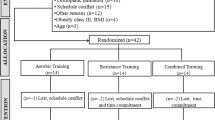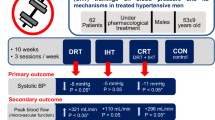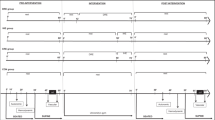Abstract
Chronic aerobic exercise lowers blood pressure (BP), peripheral resistance and cardiac work, and is used widely in antihypertensive and cardiac rehabilitation programmes. In this study, we tested the hypothesis that the cardiovascular benefits of training would occur progressively over several weeks and would diminish over a similar time course on termination of training. In all, 17 young, healthy men undertook a 4-week programme of cycle ergometry (30 min at 60% VO2peak 3–4 times/week) and 13 subjects matched for age, body mass index and fitness acted as controls. Resting BP and rate-pressure product (RPP) had fallen significantly after only 1 week's training and reached a nadir after 2 weeks training. At this time, BP had fallen from 121±7/66±6 to 110±5/57±7 mmHg and resting RPP had fallen from 85±10 to 71±9 (mmHg (beats min−1))−2 (P<0.001 each). In parallel, resting forearm conductance had risen from 0.026±0.010 to 0.052±0.029 (ml min−1) 100 ml−1 mmHg−1 and peak reactive hyperaemia following 3 min brachial artery occlusion was increased from 0.105±0.031 to 0.209±0.041 (ml min−1) 100 ml−1 mmHg−1 (P<0.001 each). No significant further circulatory changes occurred over weeks 3–4 of training. On cessation of training, all values returned to pretraining levels within between 1 (SBP, RPP, vascular conductance) and 2 (DBP, MAP, heart rate, reactive hyperaemia) weeks. The results indicate that the optimal cardiovascular benefits of moderate exercise occur rapidly. At least with short training programmes, the benefits regress once training stops just as quickly as they appeared.
This is a preview of subscription content, access via your institution
Access options
Subscribe to this journal
Receive 12 digital issues and online access to articles
$119.00 per year
only $9.92 per issue
Buy this article
- Purchase on Springer Link
- Instant access to full article PDF
Prices may be subject to local taxes which are calculated during checkout



Similar content being viewed by others
References
Kelley GA, Kelley KA, Tran ZV . Aerobic exercise and resting blood pressure: a meta-analytic review of randomized, controlled trials. Prev Cardiol 2001; 4: 73–80.
Whelton SP, Chin A, Xin X, He J . Effect of aerobic exercise on blood pressure: a meta-analysis of randomized, controlled trials. Ann Intern Med 2002; 136: 493–503.
Sartorio A, LaFortuna CL, Marinone PG, Tavani A, Vecchia C, Bosetti C . Short-term effects of two integrated, non-pharmacological body weight reduction programs on coronary heart disease risk factors in young obese patients. Diabetes Nutr Metab 2003; 16: 262–265.
O'Donovan G, Owen A, Bird SR, Kearney EM, Nevill AM, Jones DW et al. Changes in cardiorespiratory fitness and coronary artery disease risk factors following 24 wk of moderate- or high-intensity exercise of equal energy cost. J Appl Physiol 2005; 98: 1619–1625.
Pollock ML, Schmidt DH . Heart Disease and Rehabilitation. Human Kinetics: Champaign, IL, 1995.
Wilmore JH, Stanforth PR, Gagnon J, Rice T, Mandel S, Leon AS et al. Heart rate and blood pressure changes with endurance training: the HERITAGE family study. Med Sci Sports Exerc 2001; 33: 107–116.
Nami R, Mondillo S, Agricola E, Lenti S, Ferro G, Nami N et al. Aerobic exercise fails to reduce blood pressure in nondipper-type hypertension. Am J Hypert 2000; 13: 593–600.
Meredith IT, Jennings GL, Esler MD, Dewar EM, Bruce AM, Fazio VA et al. Time-course of the antihypertensive and autonomic effects of regular endurance exercise in human subjects. J Hypertens 1990; 8: 859–866.
O'Sullivan SE, Bell C . Training reduces autonomic cardiovascular responses to both exercise-dependent and -independent stimuli in humans. Auton Neurosci 2001; 91: 76–84.
Maiorana A, O'Driscoll G, Taylor R, Green D . Exercise and the nitric oxide vasodilator system. Sports Med 2003; 33: 1013–1035.
Kingwell BA, Sherrard B, Jennings GL, Dart AM . Four weeks of cycle training increases basal production of nitric oxide from the forearm. Am J Physiol 1997; 272: H1070–H1077.
O'Sullivan SE . The effects of exercise training on markers of endothelial function in young healthy men. Int J Sports Med 2003; 24: 404–409.
Grassi G, Seraville G, Calhoun DA, Mancia G . Physical training and baroreceptor control of sympathetic nerve activity in humans. Hypertension 1994; 23: 294–301.
Greiwe JS, Sciaraffa D, Shvartz E, Keil LC, Brock PJ . Norepinephrine response to exercise at the same relative intensity before and after endurance exercise training. J Appl Physiol 1999; 86: 531–535.
Fisher WJ, White MJ . Training-induced adaptations in the central command and peripheral reflex components of the pressor response to isometric exercise of the human triceps surae. J Physiol (Lond) 1999; 520: 621–628.
Halliwill JR, Taylor JA, Eckberg DL . Impaired sympathetic vascular regulation in humans after acute dynamic exercise. J Physiol (London) 1996; 495: 279–288.
Millasseau SC, Kelly RP, Ritter JM, Chowienczyk PJ . Determination of age-related increases in large artery stiffness by digital pulse contour analysis. Clin Sci 2002; 103: 371–377.
Duprez DA, Kaiser DR, Whitwam W, Finkelstein S, Belalcazar A, Patterson R et al. Determinants of radial artery pulse analysis in asymptomatic individuals. Am J Hypertens 2004; 17: 647–653.
Nichols WW . Clinical measurement of arterial stiffness obtained from non-invasive pressure waveforms. Am J Hypertens 2005; 18: 3S–10S.
Park JB, Charbonneau F, Schiffrin EL . Correlation of endothelial function in large and small arteries in human essential hypertension. J Hypertens 2001; 19: 415–420.
Stanger O, Semmelrock HJ, Wonisch W, Bos U, Pabst E, Wascher TC . Effects of folate treatment and homocysteine lowering on resistance vessel reactivity in atherosclerotic subjects. J Pharmacol Exp Ther 2002; 303: 158–162.
Allen JD, Cobb FR, Gow AJ . Regional and whole-body markers of nitric oxide production following hyperemic stimuli. Free Radic Biol Med 2005; 38: 1164–1169.
Meredith IT, Currie KE, Anderson TJ, Roddy MA, Ganz P, Creager M . Post-ischemic vasodilation in human forearm is dependent on endothelium-derived nitric oxide. Am J Physiol 1996; 270: H1435–H1440.
Tentolouris C, Tousoulis D, Antoniades C, Bosinakou E, Kotsopoulou M, Trikas A et al. Endothelial function and proinflammatory cytokines in patients with ischemic heart disease and dilated cardiomyopathy. Int J Cardiol 2004; 94: 301–305.
Delaney T, Bell C . Short latency of human cardiovascular responses to training. J Physiol (London) 2005; 560P: C15 (Abstract).
Edwards DC, Lang JT . Augmentation index and systolic load are lower in competitive endurance athletes. Am J Hypertens 2005; 18: 679–683.
Tanaka H, Dinenno FA, Monahan KD, Clevenger CM, DeSouza CA, Seals DR . Aging, habitual exercise, and dynamic arterial compliance. Circulation 2000; 102: 1270–1275.
Vaitkevicius PV, Fleg JL, Engel JH, O'Connor FC, Wright JG, Lakatta LE et al. Effects of age and aerobic capacity on arterial stiffness in healthy adults. Circulation 1993; 88: 1456–1462.
Esler M . Differentiation in the effects of the angiotensin II receptor blocker class on autonomic function. J Hypertens 2002; 20(Suppl): S13–S19.
Thrasher TN . Baroreceptors, baroreceptor unloading, and the long-term control of blood pressure. Am J Physiol 2005; 288: R819–R827.
Glasser SP . On arterial physiology, pathophysiology of vascular compliance, and cardiovascular disease. Heart Dis 2000; 2: 375–379.
Wilkinson IB, Franklin SS, Cockcroft JR . Nitric oxide and the regulation of large artery stiffness: from physiology to pharmacology. Hypertension 2004; 44: 112–116.
Kokkinos PF, Narayan P, Papademetriou V . Exercise as hypertension therapy. Cardiol Clin 2001; 19: 507–516.
Hagberg JM, Park JJ, Brown MD . The role of exercise training in the treatment of hypertension: an update. Sports Med 2000; 30: 193–206.
Ishikawa-Takata K, Ohta T, Tanaka H . How much exercise is required to reduce blood pressure in essential hypertensives: a dose–response study. Am J Hypertens 2003; 16: 629–633.
Fagard RH . Exercise characteristics and the blood pressure response to dynamic physical training. Med Sci Sports Exerc 2001; 33(Suppl): S484–S492.
Acknowledgements
We wish to thank Mr Bernard Donne for statistical advice and assistance with metabolic measurements, and Mr Aidan Kelly for expert technical assistance.
Author information
Authors and Affiliations
Corresponding author
Rights and permissions
About this article
Cite this article
Murray, Á., Delaney, T. & Bell, C. Rapid onset and offset of circulatory adaptations to exercise training in men. J Hum Hypertens 20, 193–200 (2006). https://doi.org/10.1038/sj.jhh.1001970
Received:
Revised:
Accepted:
Published:
Issue Date:
DOI: https://doi.org/10.1038/sj.jhh.1001970
Keywords
This article is cited by
-
Irisin and exercise training in humans – Results from a randomized controlled training trial
BMC Medicine (2013)
-
Rapid vascular modifications to localized rhythmic handgrip training and detraining
European Journal of Applied Physiology (2010)



